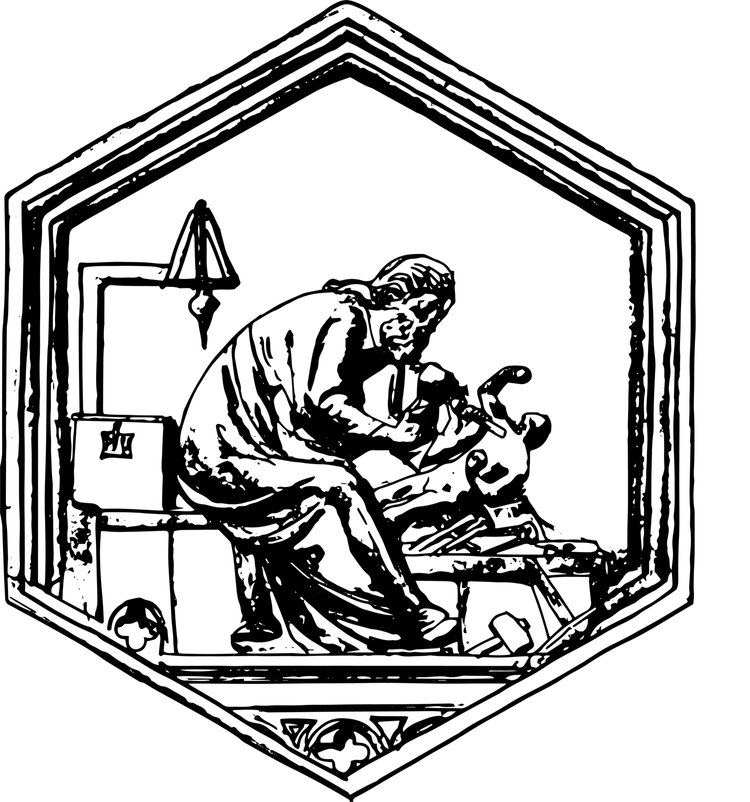
Twelve Apostles
The Twelve Apostles are carved into the lintel of the Great Portal at Annunciation Abbey in Oklahoma. The lintel is ten feet wide and twenty inches tall, and is comprised of a single slab of Batesville Marble. (Completion date: April 2013)

The Theological Dispute; Simon, James the Less, and Jude
The artist’s intention was to work within a Romanesque idiom, but to give each apostle an individual personality, and a degree of interaction with the other figures in the composition. In this group, Simon is shown engaged in a lively dispute with Jude. James the Less is placidly writing his Epistle in the midst of the clamor on either side.
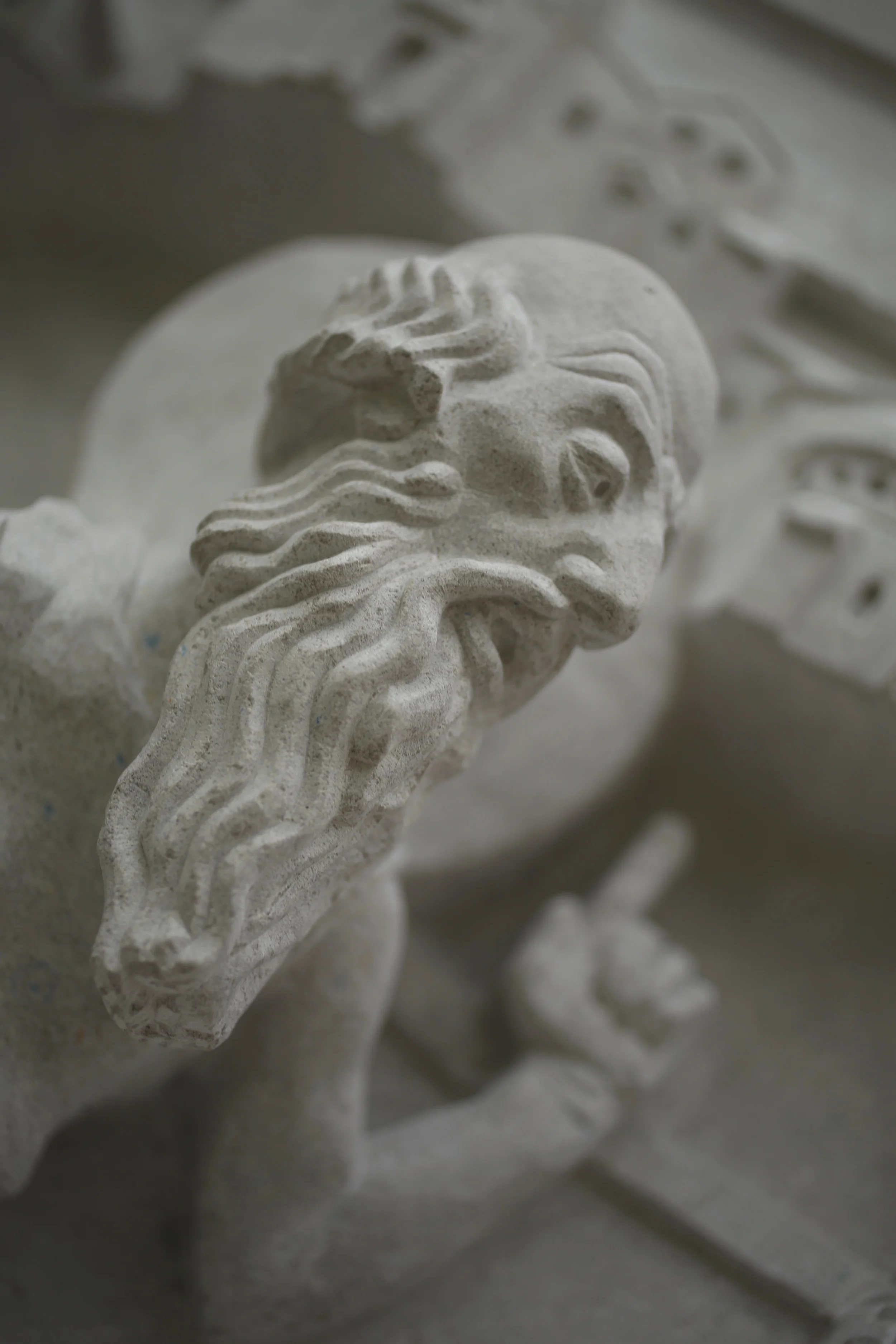
Simon
The stone the Apostles are carved out of, Batesville Marble is not a true marble, but a very dense limestone. The tight grain of this stone allows it to accept the carving of very fine detail. When the stone is cut to a smooth finish, it becomes mildly reflective, allowing the gray stone to take on hints of blue reflected from the sky.

James the Less
Each of Christ’s disciples can be identified by one or more attributes, or objects traditionally associated with a particular saint. With the exception of St. John, who died of natural causes, each apostle is shown taking ownership of the particular implement of his martyrdom. St. James the Less, first Bishop of Jerusalem, is said to have met his death at the hands of a mob of felt-makers and is therefore shown holding a fuller’s club in his left hand as he writes his Epistles with his right.

Jude
Another advantage of working with Batesville Marble is it’s durability and internal strength. These characteristics enable the very high relief method of carving employed in this project. The Apostles were carved in-situ due to the fact that the stone is an integral architectural component of the Abbey Church.

Fishers of Men; Thomas, Andrew, and Peter
In this group, St. Thomas, the Evangelist to India, is seated on a throne inspired by Indian design motifs. Andrew and his brother Peter, are shown clutching a net filled with struggling fish. This symbol refers to the work with which they where engaged when called to follow Christ, by the famous words of Jesus, “I will make you fishers of Men.”
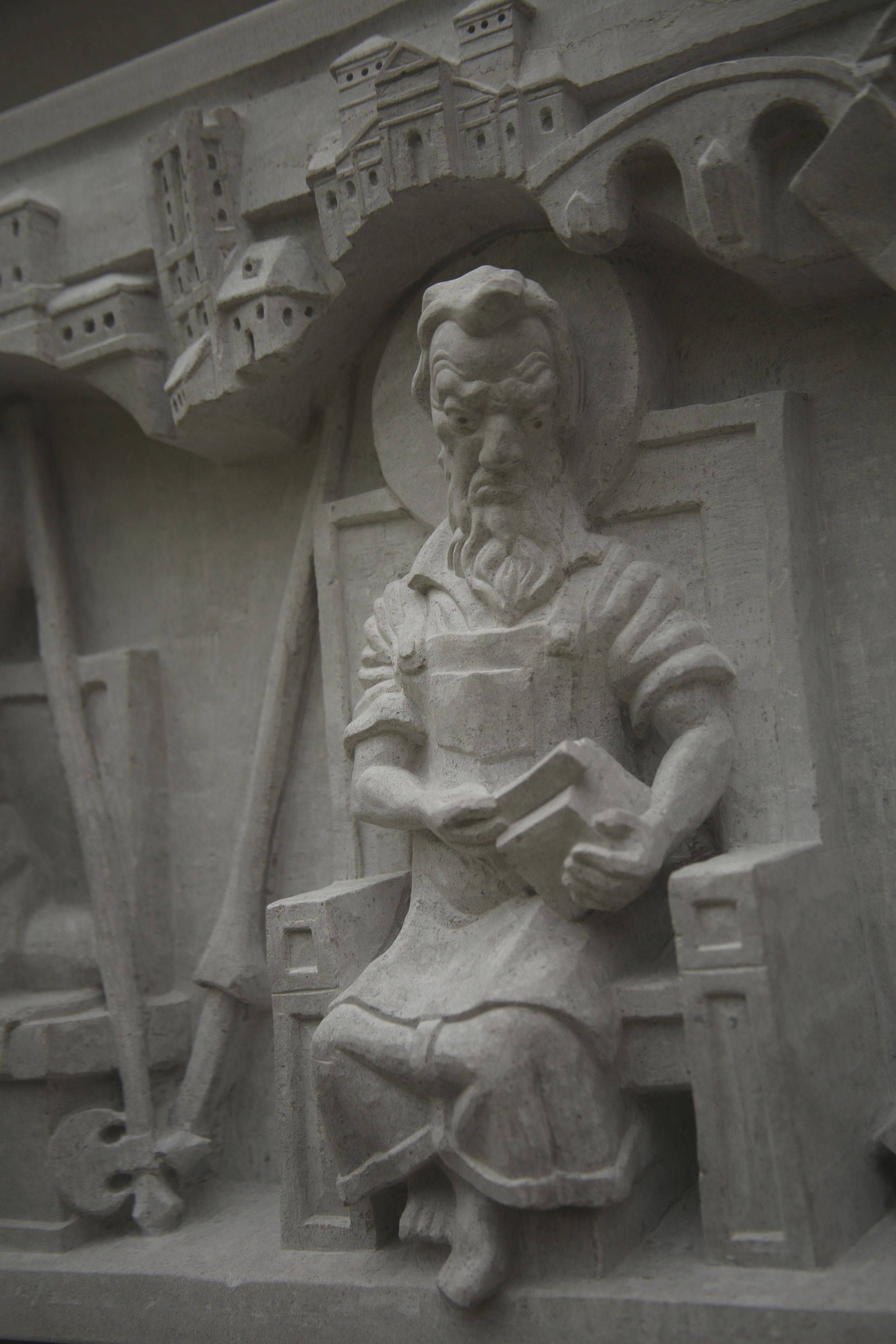
Thomas
St. Thomas, the patron saint of builders and architects, is famous for his episode as ‘Doubting Thomas’ when he questioned the news of Christ’s resurrection and insisted on confirming the testimony with his own senses. In this composition, he is shown using a builder’s square to test the ‘trueness’ of a right angle on a block of stone. Leaning against the throne is the lance with which he was martyred.
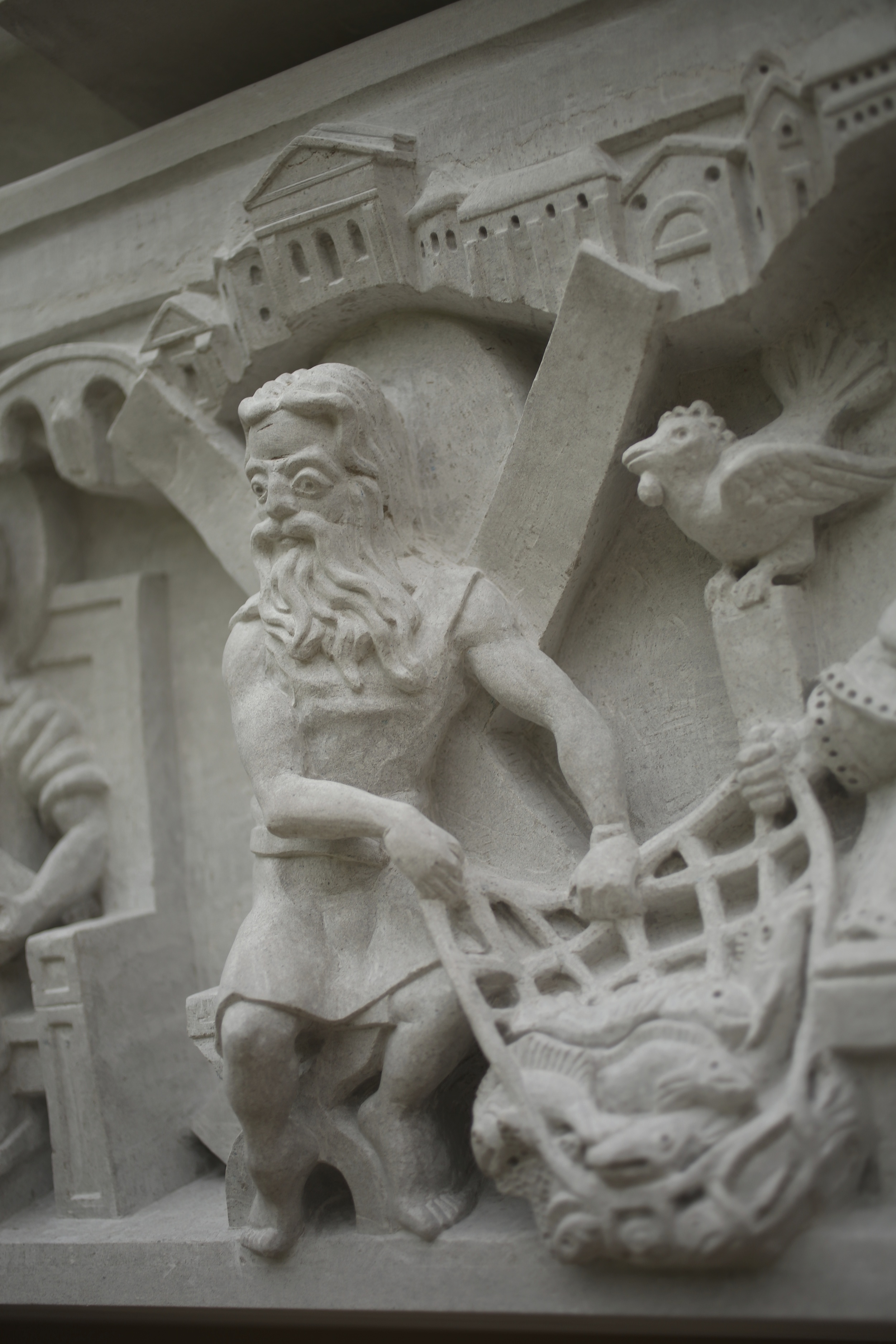
Andrew
St. Andrew is depicted in the humble garb of a fisherman as he hauls in his catch. He is seated on an X-frame stool which, along with the diagonally crossed wooden beams in the back-ground, indicates the geometry of his crucifixion.
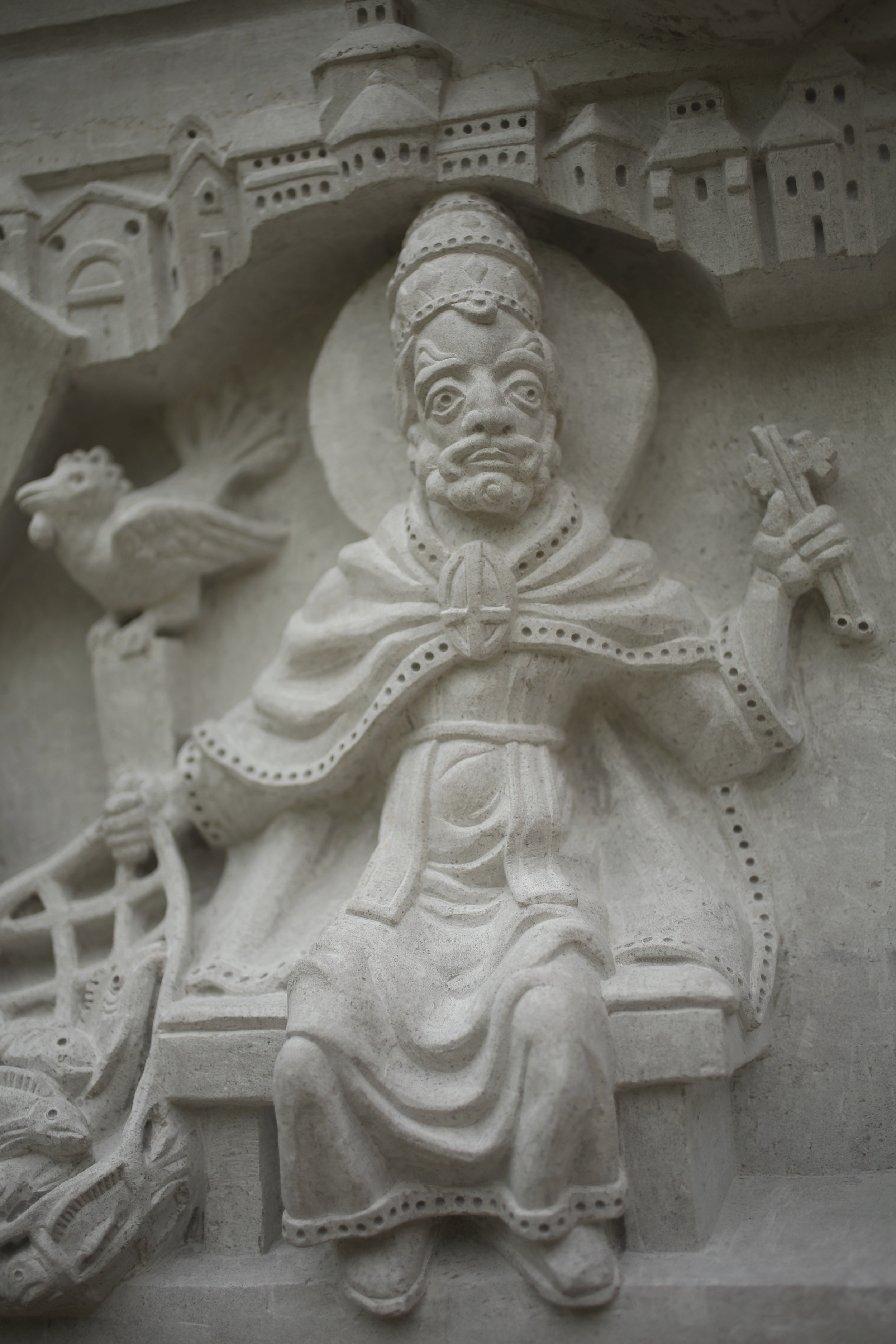
Peter
St. Peter, leader of the disciples and first pontiff, is thrice-crowned with the papal tiara, an allegory of the Trinity. In his left hand, he holds the keys, a symbol of his authority "to loose and to bind.” Over his right shoulder is perched the famous cock from the Gospels, a reminder of Peter’s threefold denial of Christ. The clasp holding together the saint’s cope is in the form of an inverted cross, recalling Peter’s upside-down crucifixion.

The sons of Thunder; John, James, and Mathew
The Apostles are shown enthroned in the ‘Heavenly Jerusalem’ as indicated by the register of churches and other buildings that have been carved into the molding above each saint’s head. The arches are surmounted by particular French Romanesque churches, evoking the Abbey’s deep roots in the Congregation of Solemnes. Several of the churches depicted influenced the design of the Abbey Church at Clear Creek.

John
St. John, the Beloved of Christ, is identified by his lack of facial hair, indicating his youth, and the chalice that he holds in his left hand. The pose of this figure is intended to evoke the ecstasy experienced when a soul is perfectly aligned to the Will of God.

James the Greater
St. James the Greater is shown in the guise of a pilgrim on route to the Shrine of Santiago in Spain. He carries the staff of a pilgrim and wears a sea shell in his hat, the symbol of baptism. The Christian life may be understood as a pilgrimage from earth to heaven. St. James wearily rests his booted feet along the way, but is resolved to continue on his journey undaunted.
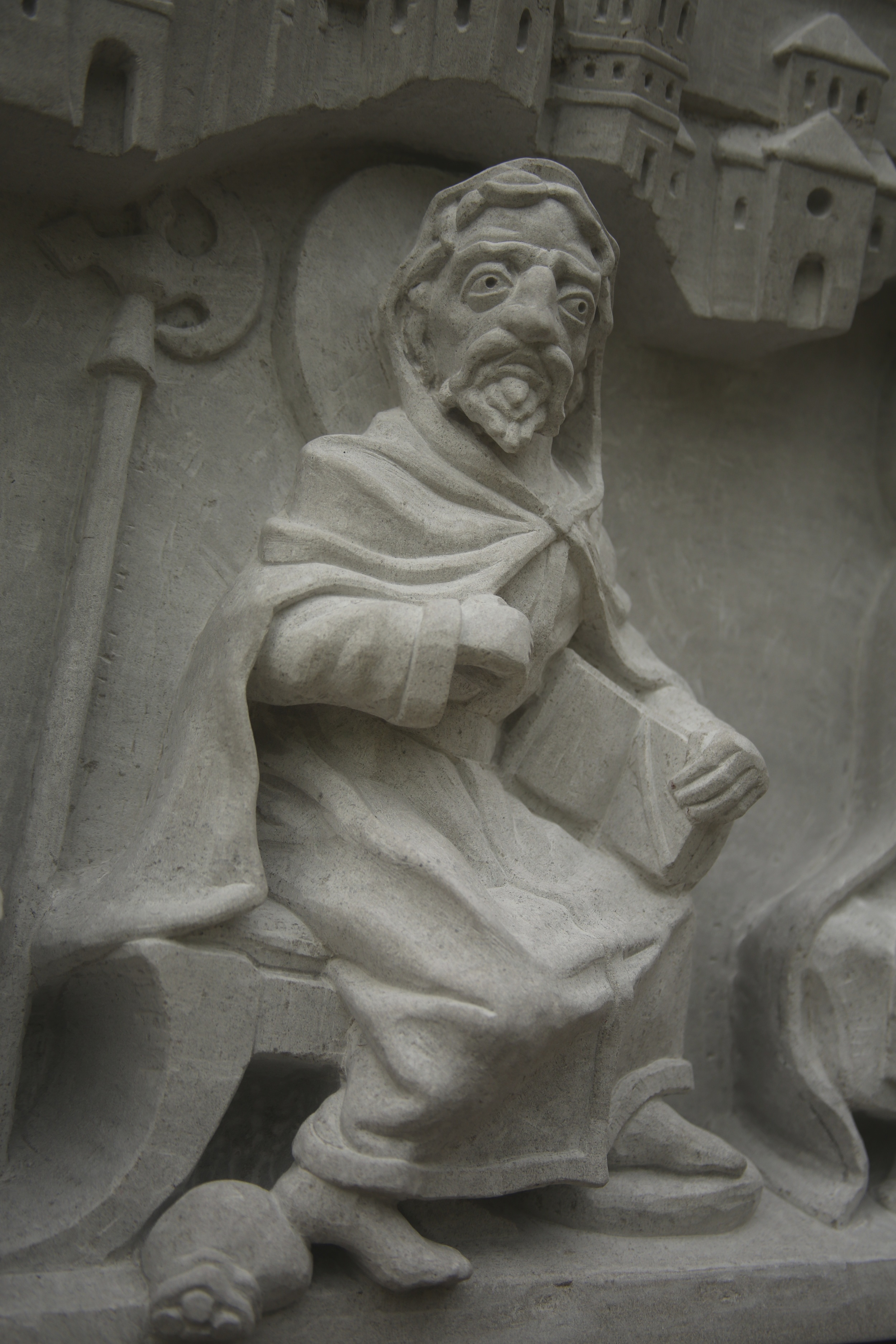
Mathew
One of the four Evangelists, St. Mathew points toward his Gospel and invites the viewer to follow Christ. Mathew’s abandonment of his earlier career as a tax-collector is alluded to by the sack of coins that he kicks over the edge of the sculpture.
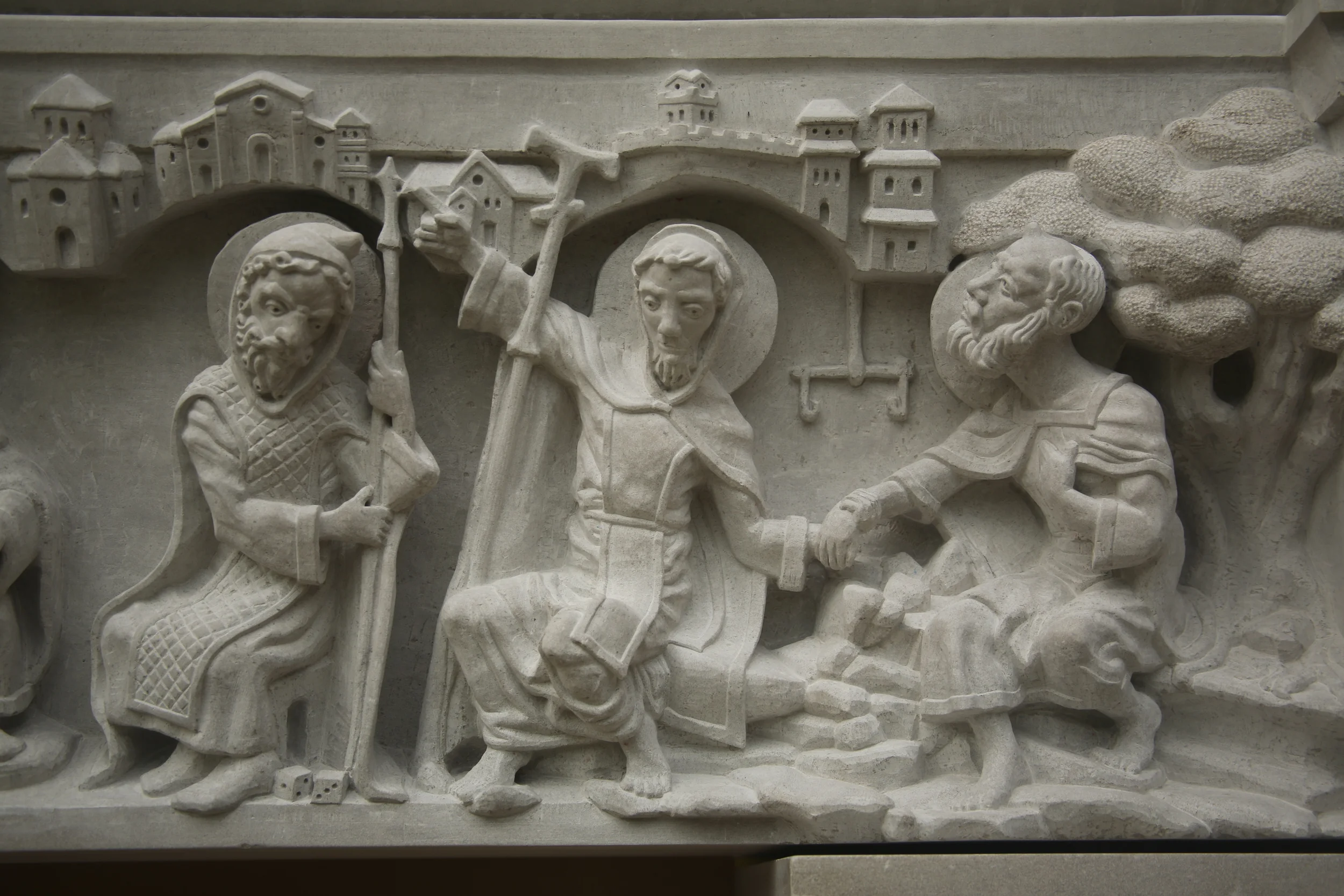
True Israelites; Mathias, Philip, and Nathaniel
In this portion of the composition, the central figure, St. Philip, is shown leading Nathaniel to Christ. This refers to the account given by John in the first chapter of his Gospel. Upon hearing the news of Jesus’s coming, Nathaniel is dubious saying, “What good can come out of Nazareth?” prompting Philip to answer, “Come and see.” Upon encountering Jesus for the first time, Nathaniel is convinced and acknowledges Christ as the Son of God and King of Israel.

Mathias
St. Mathias, the follower of Christ who was chosen to replace Judas, is shown forebodingly contemplating the cast by lot that has elevated him to the position of Apostle.

Philip
St. Philip of Bethesda, holds a staff surmounted with the design of a cross, alluding to his death by crucifixion. He points heavenward as he leads Nathaniel to Jesus.
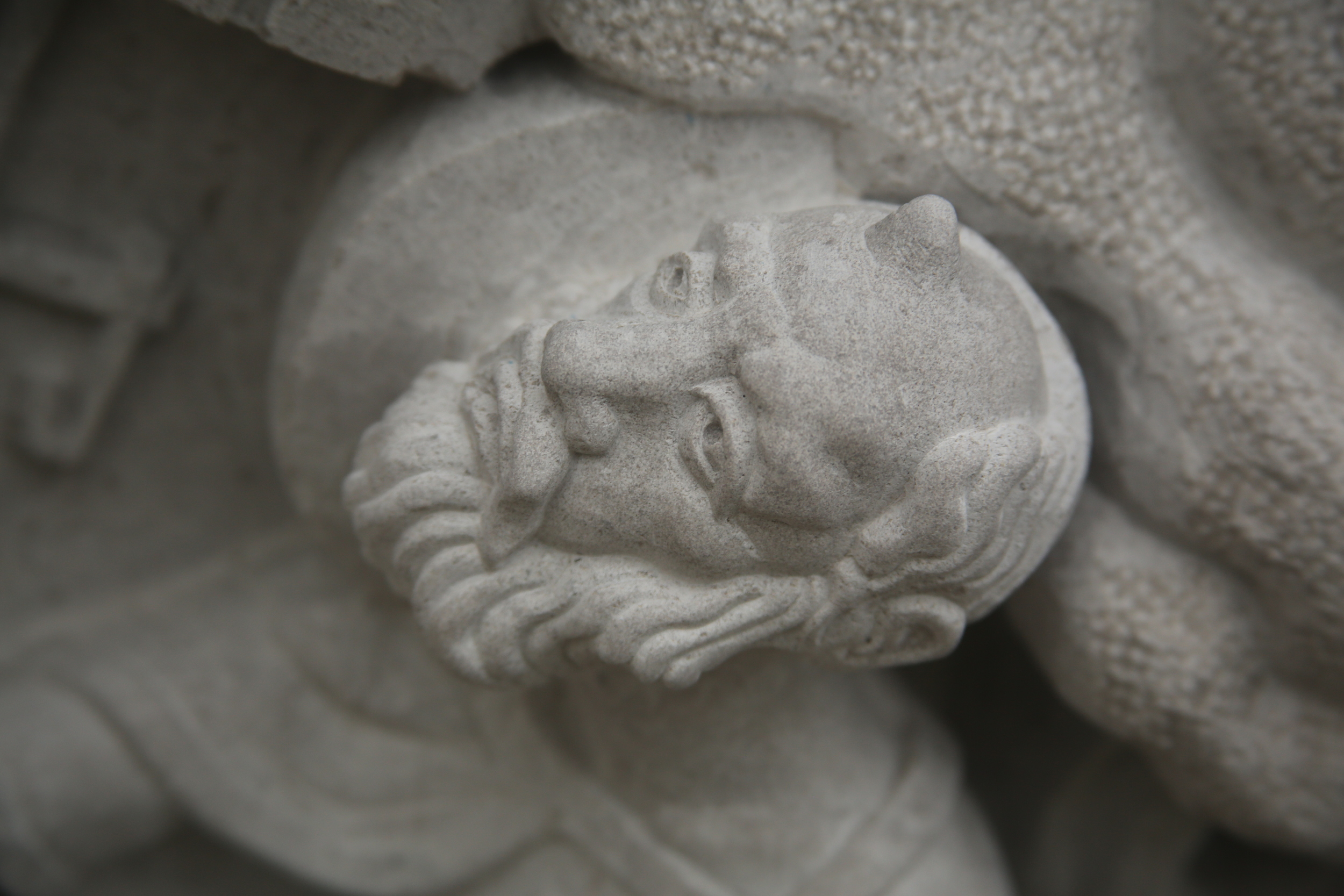
Nathaniel/Bartholomew
St. Nathaniel, also known as Bartholomew, sits under a fig tree, which is a symbol of Israel and also refers to the words of Christ, “Before Philip called you, I saw you under the fig tree.” The famous martyrdom of Bartholomew, death by being flayed alive, is foreshadowed in the space between Philip and Bartholomew by a gambrel, the instrument used by butchers for hanging large carcasses by the legs.
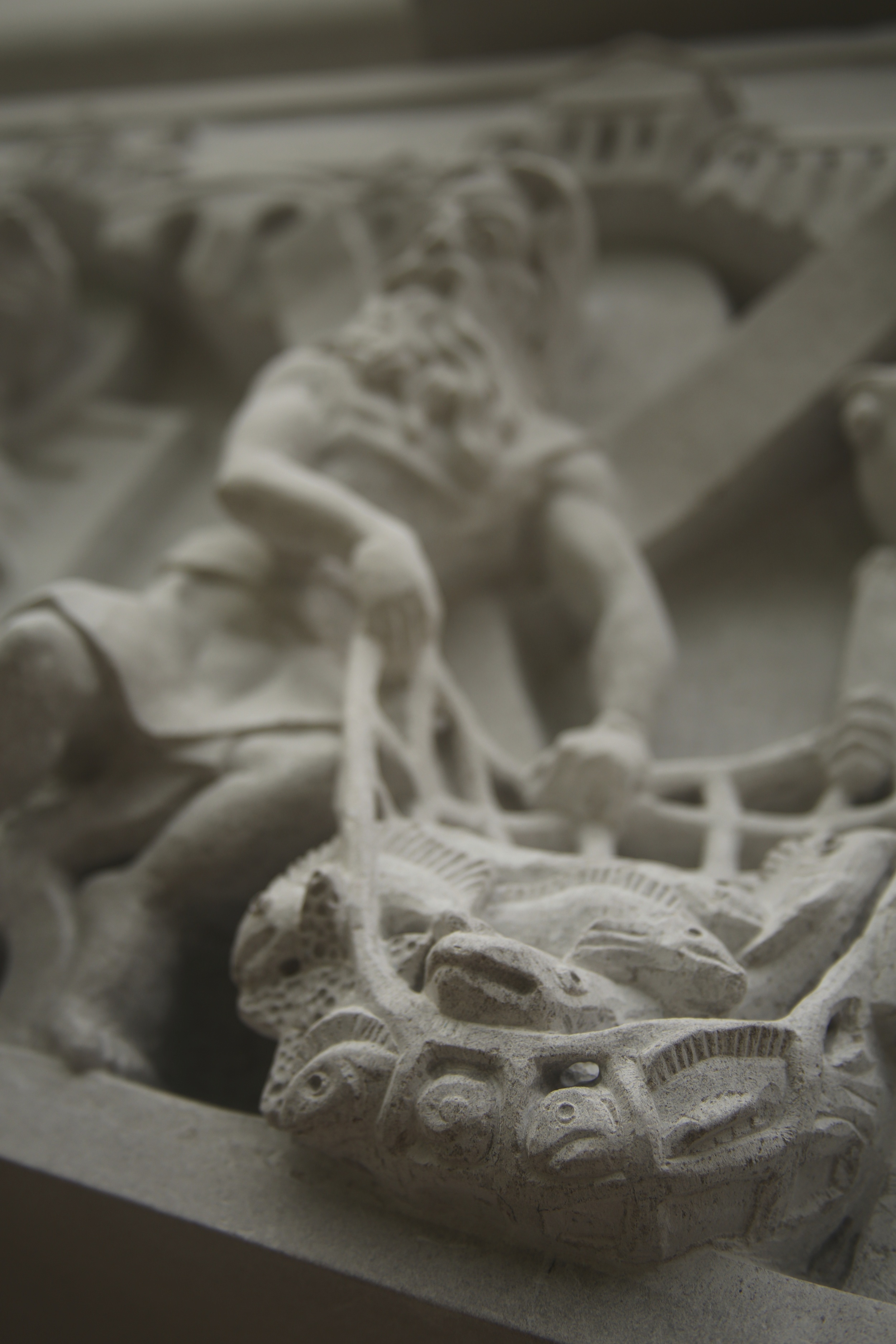
Close up of fishing net
Andrew hoists the weight of the overloaded fishing net.
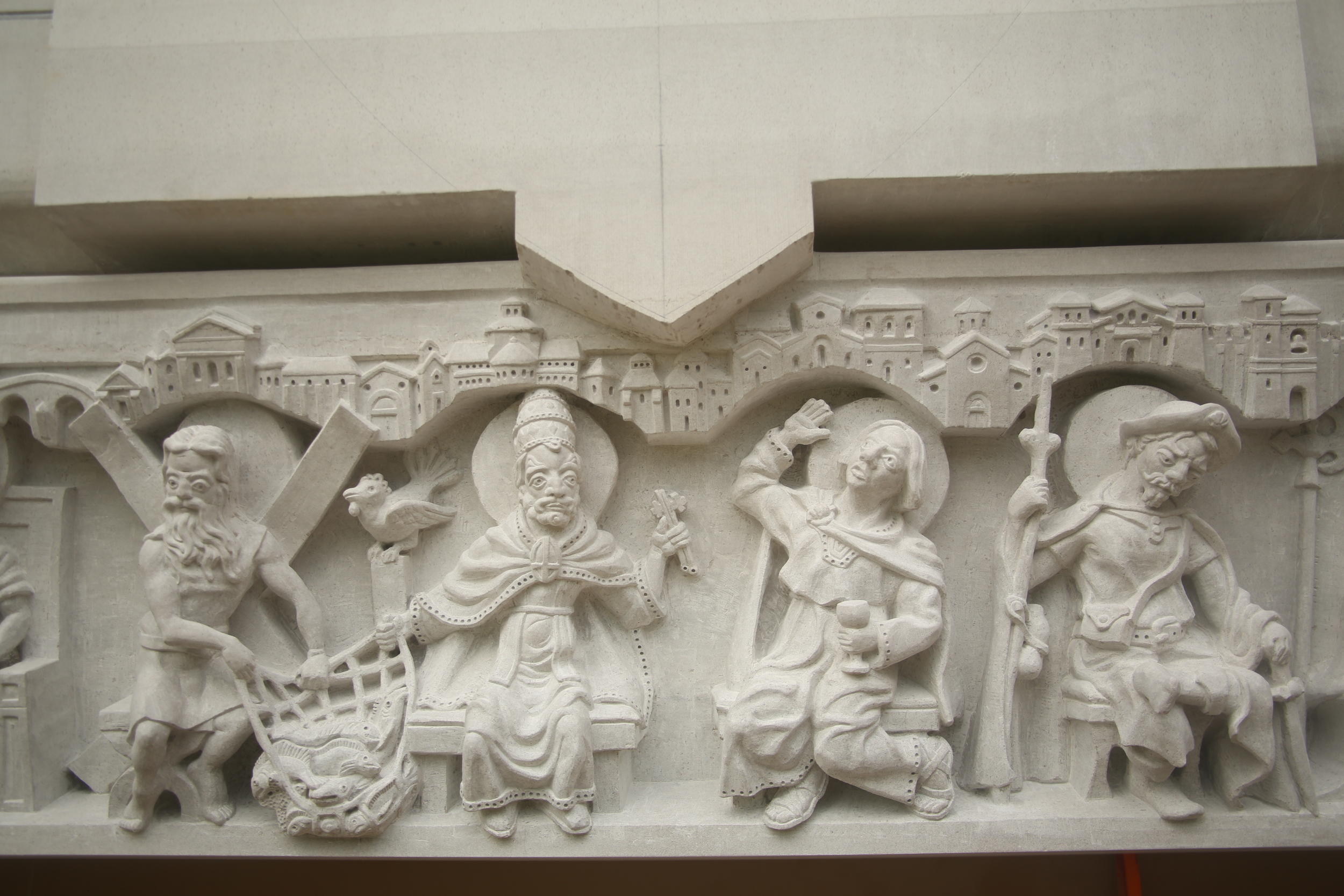
Central four figures of the composition
From left to right: Andrew, Peter, John, and James the Greater.

Side view
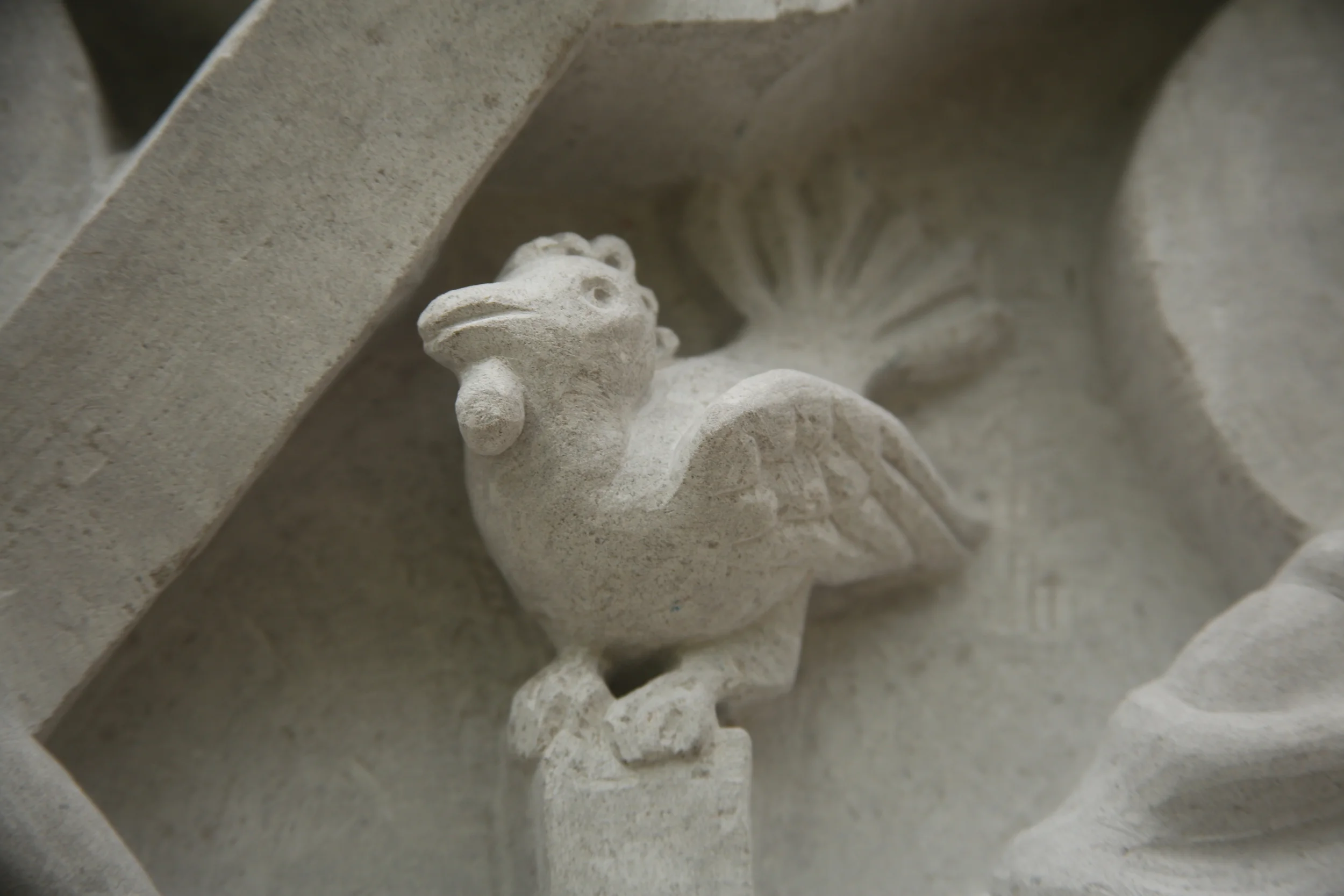
Rooster
The rooster is perched on a post between the figures of Peter and Andrew.
Twelve Apostles
The Twelve Apostles are carved into the lintel of the Great Portal at Annunciation Abbey in Oklahoma. The lintel is ten feet wide and twenty inches tall, and is comprised of a single slab of Batesville Marble. (Completion date: April 2013)
The Theological Dispute; Simon, James the Less, and Jude
The artist’s intention was to work within a Romanesque idiom, but to give each apostle an individual personality, and a degree of interaction with the other figures in the composition. In this group, Simon is shown engaged in a lively dispute with Jude. James the Less is placidly writing his Epistle in the midst of the clamor on either side.
Simon
The stone the Apostles are carved out of, Batesville Marble is not a true marble, but a very dense limestone. The tight grain of this stone allows it to accept the carving of very fine detail. When the stone is cut to a smooth finish, it becomes mildly reflective, allowing the gray stone to take on hints of blue reflected from the sky.
James the Less
Each of Christ’s disciples can be identified by one or more attributes, or objects traditionally associated with a particular saint. With the exception of St. John, who died of natural causes, each apostle is shown taking ownership of the particular implement of his martyrdom. St. James the Less, first Bishop of Jerusalem, is said to have met his death at the hands of a mob of felt-makers and is therefore shown holding a fuller’s club in his left hand as he writes his Epistles with his right.
Jude
Another advantage of working with Batesville Marble is it’s durability and internal strength. These characteristics enable the very high relief method of carving employed in this project. The Apostles were carved in-situ due to the fact that the stone is an integral architectural component of the Abbey Church.
Fishers of Men; Thomas, Andrew, and Peter
In this group, St. Thomas, the Evangelist to India, is seated on a throne inspired by Indian design motifs. Andrew and his brother Peter, are shown clutching a net filled with struggling fish. This symbol refers to the work with which they where engaged when called to follow Christ, by the famous words of Jesus, “I will make you fishers of Men.”
Thomas
St. Thomas, the patron saint of builders and architects, is famous for his episode as ‘Doubting Thomas’ when he questioned the news of Christ’s resurrection and insisted on confirming the testimony with his own senses. In this composition, he is shown using a builder’s square to test the ‘trueness’ of a right angle on a block of stone. Leaning against the throne is the lance with which he was martyred.
Andrew
St. Andrew is depicted in the humble garb of a fisherman as he hauls in his catch. He is seated on an X-frame stool which, along with the diagonally crossed wooden beams in the back-ground, indicates the geometry of his crucifixion.
Peter
St. Peter, leader of the disciples and first pontiff, is thrice-crowned with the papal tiara, an allegory of the Trinity. In his left hand, he holds the keys, a symbol of his authority "to loose and to bind.” Over his right shoulder is perched the famous cock from the Gospels, a reminder of Peter’s threefold denial of Christ. The clasp holding together the saint’s cope is in the form of an inverted cross, recalling Peter’s upside-down crucifixion.
The sons of Thunder; John, James, and Mathew
The Apostles are shown enthroned in the ‘Heavenly Jerusalem’ as indicated by the register of churches and other buildings that have been carved into the molding above each saint’s head. The arches are surmounted by particular French Romanesque churches, evoking the Abbey’s deep roots in the Congregation of Solemnes. Several of the churches depicted influenced the design of the Abbey Church at Clear Creek.
John
St. John, the Beloved of Christ, is identified by his lack of facial hair, indicating his youth, and the chalice that he holds in his left hand. The pose of this figure is intended to evoke the ecstasy experienced when a soul is perfectly aligned to the Will of God.
James the Greater
St. James the Greater is shown in the guise of a pilgrim on route to the Shrine of Santiago in Spain. He carries the staff of a pilgrim and wears a sea shell in his hat, the symbol of baptism. The Christian life may be understood as a pilgrimage from earth to heaven. St. James wearily rests his booted feet along the way, but is resolved to continue on his journey undaunted.
Mathew
One of the four Evangelists, St. Mathew points toward his Gospel and invites the viewer to follow Christ. Mathew’s abandonment of his earlier career as a tax-collector is alluded to by the sack of coins that he kicks over the edge of the sculpture.
True Israelites; Mathias, Philip, and Nathaniel
In this portion of the composition, the central figure, St. Philip, is shown leading Nathaniel to Christ. This refers to the account given by John in the first chapter of his Gospel. Upon hearing the news of Jesus’s coming, Nathaniel is dubious saying, “What good can come out of Nazareth?” prompting Philip to answer, “Come and see.” Upon encountering Jesus for the first time, Nathaniel is convinced and acknowledges Christ as the Son of God and King of Israel.
Mathias
St. Mathias, the follower of Christ who was chosen to replace Judas, is shown forebodingly contemplating the cast by lot that has elevated him to the position of Apostle.
Philip
St. Philip of Bethesda, holds a staff surmounted with the design of a cross, alluding to his death by crucifixion. He points heavenward as he leads Nathaniel to Jesus.
Nathaniel/Bartholomew
St. Nathaniel, also known as Bartholomew, sits under a fig tree, which is a symbol of Israel and also refers to the words of Christ, “Before Philip called you, I saw you under the fig tree.” The famous martyrdom of Bartholomew, death by being flayed alive, is foreshadowed in the space between Philip and Bartholomew by a gambrel, the instrument used by butchers for hanging large carcasses by the legs.
Close up of fishing net
Andrew hoists the weight of the overloaded fishing net.
Central four figures of the composition
From left to right: Andrew, Peter, John, and James the Greater.
Side view
Rooster
The rooster is perched on a post between the figures of Peter and Andrew.





















